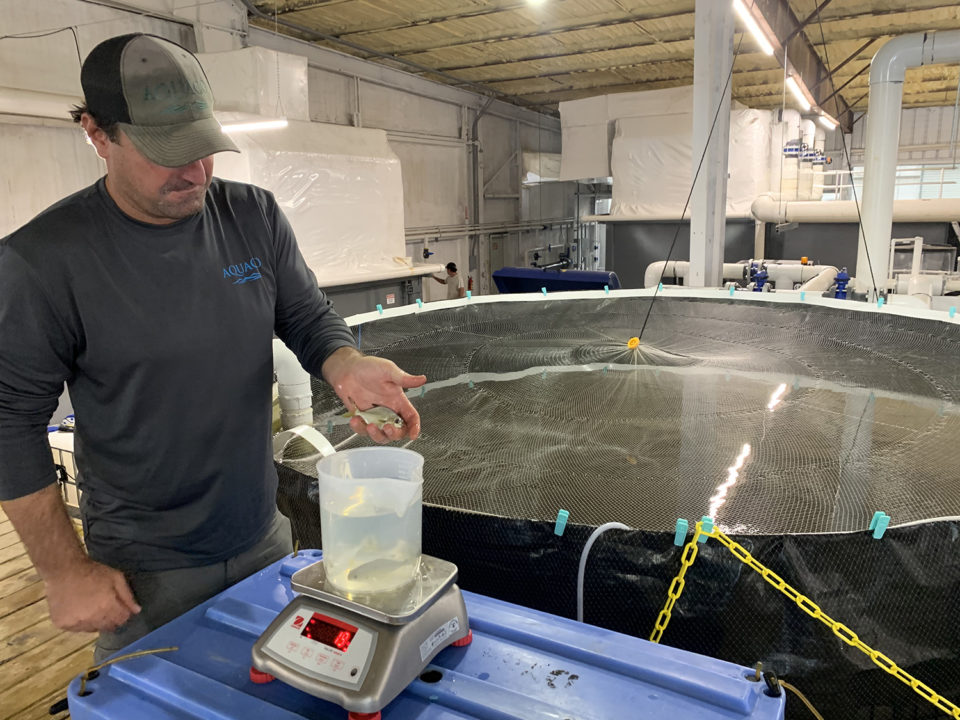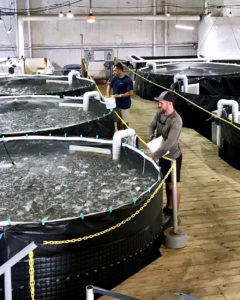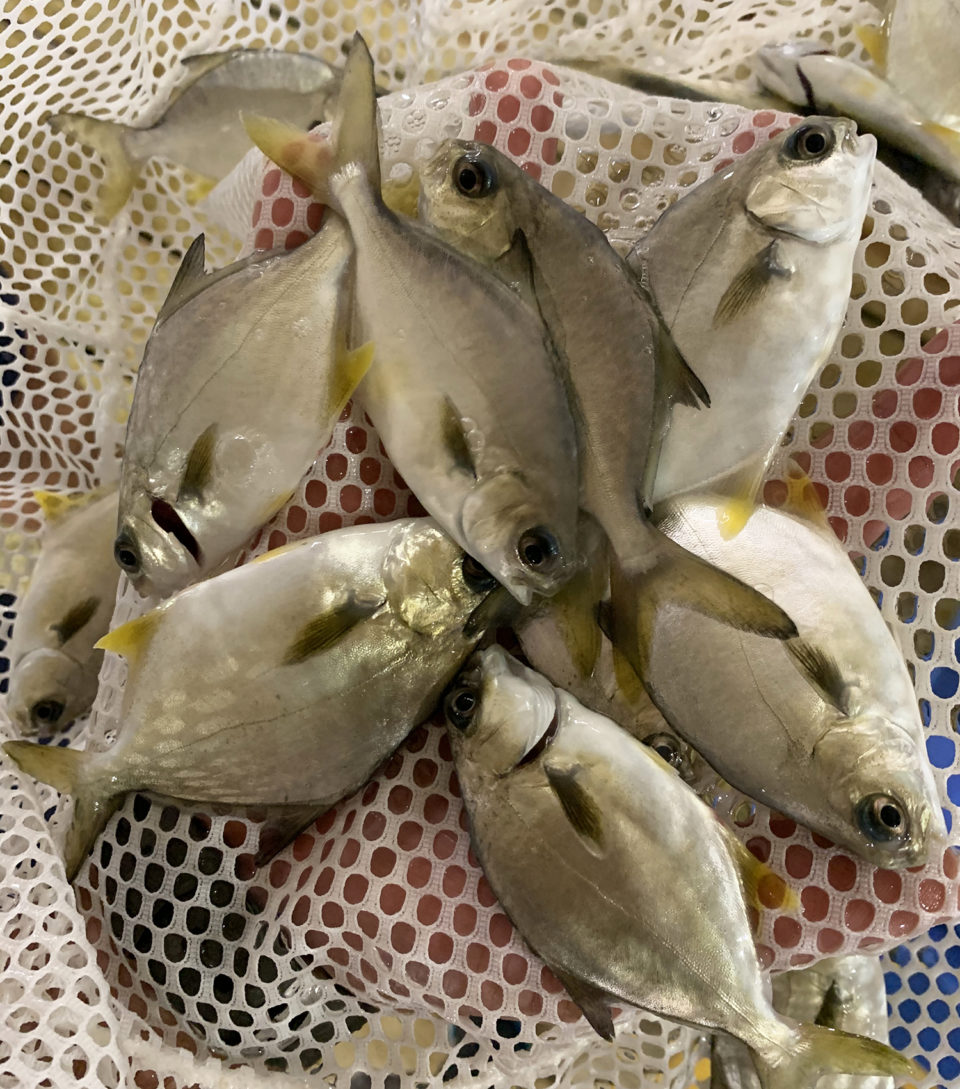Aquaculture entrepreneur thinks he can succeed with RAS where others have failed

When it comes to raising Florida pompano, Joe Cardenas knew the success stories were limited but that didn’t deter the banker-turned-aquaculture entrepreneur from moving forward with his plan to raise the fish.
“I looked at the failures – and there have been a lot – and the majority of them were not because of the species,” Cardenas told the Advocate. “There were biologists starting aquaculture companies that failed on the business side and business people starting aquaculture companies that failed because of lack of knowledge [of raising fish].
In 2015, Cardenas launched Aquaco. He raised $3 million to build the 20,000-square-foot recirculating aquaculture (RAS) facility in Fort Pierce, Fla. When the first 10,000 fingerlings went into the tanks last July, Cardenas became the sole producer of RAS-grown Florida pompano in North America.
“The fish are growing a little bit faster than we thought, handling higher densities than we thought and the [feed] conversion is in line with our estimates,” he said.
Betting the farm on pompano

It took a long time to get to this moment. Before raising capital or signing off on construction, Cardenas evaluated several different species, including flounder, snapper and snook. Pompano, he believed, provided the best chance for success.
“Of all the species we looked at, pompano was the only one that really was out of the [research and development] phase,” Cardenas says. “There are still tons of opportunities to learn about them … but we knew going in that pompano worked well on the hatchery side and there had been enough work on the grow-out side that we had about 80 percent of the answers.”
Cardenas believes there are still lots of opportunities to learn more about pompano aquaculture. Schools like Auburn University and University of Miami have conducted research on pompano and Florida Atlantic University Harbor Branch Oceanographic Institute received a $710,000 grant through the Sea Grant National Aquaculture Initiative to research feed additives, improve feed efficiency and reduce waste for pompano raised in RAS facilities. The research is still in its infancy, so the data has not yet led to pompano-specific feeds or vaccines.
“The familiarity in regards to the species characteristics, the hatchery supply, the growing methods, the feeds, disease issues and vaccine development [means] there is a big learning curve [with pompano],” said Steve Eddy, director for the Center for Cooperative Aquaculture Research at the University of Maine.
These challenges are among the reasons pompano aquaculture has suffered several failed ventures, including the closure of Oceanus Seafood in Homestead, Fla., where the founders invested a reported $10 million to raise pompano in land-based tanks.
“It would have been easier to raise salmon,” Cardenas says. “It’s almost a commodity, which means there isn’t much guesswork.”
Overcoming obstacles
Cardenas struggled to access resources for broodstock, feed and vaccines that are plentiful for more commonly produced species like salmon, tilapia and trout. He found a single source for broodstock; purchased feed used for snapper, snook and other warm water fish; and connected with potential customers to ensure his pompano would go from farm to plate.
The biggest obstacle was building a system that would allow the fish to thrive. RAS, Cardenas believes, could be the key to raising pompano successfully.
“My fear, and what happened [with Oceanus Seafood], was that their design didn’t work for a saltwater system and they started realizing that they were having issues with filtering and so forth,” he said. “When we designed our systems, [I told the designers and engineers] that whatever we did in our proof of concept, I didn’t want the systems to be the limiting factor. Meaning, let’s find out what this fish will allow us to do, rather than what the systems will stop us from doing [and] it’s playing out right.”
Daniel Benetti, Ph.D., director of aquaculture at the Rosenstiel School of Aquaculture at the University of Miami, used to be skeptical about RAS but changed his thinking as a result of new technologies for filtering of solids and nitrogen that have improved stocking densities.

“The systems are better designed and capable of handling adequate biomass and stocking densities that would allow profitability without crossing that threshold that would make the systems collapse,” Benetti explained. “Because there has been so much progress with the RAS, if you raise a high-value species at high densities and, with a good team, good systems, it can be profitable.”
Cardenas knows it’ll take time before he can declare the RAS (or Aquaco) a success. In 2021, he plans to expand production to 100,000 pounds per month and estimates the price for farm-raised pompano will hit up to $7.50 per pound. As he continues to build the Aquaco brand, Cardenas hopes that other aquaculture companies will follow his lead.
“I would welcome other competitors coming online and doing pompano with open arms,” he said. “With a newer species, there could be four or five more [aquaculture companies] and we could get into production in the tens of thousands of tons and not trip on each other. If anything, it would help us to get to economies of scale [where] our feed [prices] would come down and we could start seeing pompano-specific diets. Right now, a feed manufacturer would go broke putting in the R&D to make feed for pompano and we’d be the only buyer.”
Challenges aside, aquaculture needs pioneers like Cardenas. The risk-takers and innovators are the reason that once-unknown as aquaculture species, including barramundi, cobia, sea bream and halibut are now being raised successfully. Moreover, Eddy believes that developing new species is essential for furthering the industry and potentially meeting future needs.
“It could turn out that some of [these new species] will be far more efficient than salmon or fulfill a really important market demand,” he explained.
Cardenas knows that the industry is watching and he hopes to exceed their expectations, as well as his own.
“There is a tremendous path for pompano aquaculture and we want to be the ones to show that it’s doable,” he says.
Follow the Advocate on Twitter @GAA_Advocate
Now that you've finished reading the article ...
… we hope you’ll consider supporting our mission to document the evolution of the global aquaculture industry and share our vast network of contributors’ expansive knowledge every week.
By becoming a Global Seafood Alliance member, you’re ensuring that all of the pre-competitive work we do through member benefits, resources and events can continue. Individual membership costs just $50 a year. GSA individual and corporate members receive complimentary access to a series of GOAL virtual events beginning in April. Join now.
Not a GSA member? Join us.
Author
-

Jodi Helmer
Jodi Helmer is a North Carolina-based journalist covering the business of food and farming.
Tagged With
Related Posts

Health & Welfare
Captive reproduction, larviculture of Florida pompano
U.S. trials indicated wild-caught pampano could be feed trained and spawned in captivity via hormonal induction. Observations of fecundity, egg fertilization rates, and spawning frequency suggested that quantities of pompano seedstock could be produced over time. Although survival during test larviculture was low, the trials showed pompano larvae can be reared following standard commercial practices.

Aquafeeds
Evaluating dietary fish oil replacement in juvenile Florida pompano
Study evaluated production performance and tissue composition of juvenile Florida pompano fed diets containing fish oil or 25:75 blends of fish oil and various other lipid sources.

Health & Welfare
High-soy, fishmeal-free diets support Florida pompano growth
The authors have achieved good growth using a fishmeal-free diet for the carnivorous marine fish Florida pompano. In studies, they used pompano as a model marine species in a cost/benefit analysis of two extruded diets.

Innovation & Investment
Connecticut ‘urban fish farm’ leans on RAS to produce branzino
The Ideal Fish “urban fish farm” in Connecticut is producing branzino, or European sea bass, using RAS technology. Learn about this project from the company that designed and supported it: Pentair Aquatic Eco-Systems.

